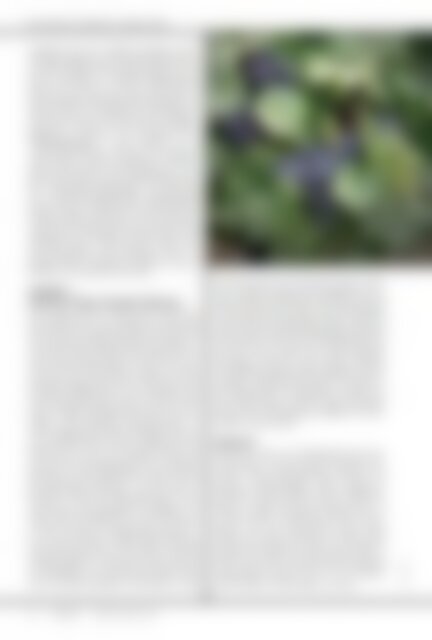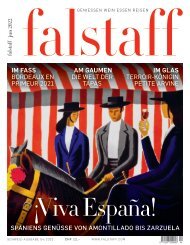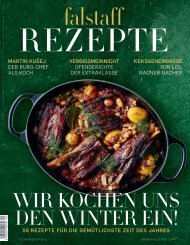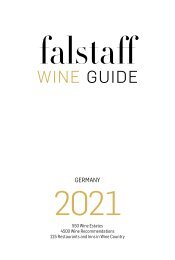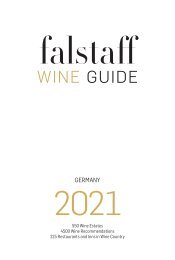You also want an ePaper? Increase the reach of your titles
YUMPU automatically turns print PDFs into web optimized ePapers that Google loves.
AUSTRIA’S <br />
GRAPE VARIETIES<br />
fränkisch wines are vinified according to international<br />
models in new French oak barrels and<br />
are often blended with small quantities of Cabernet<br />
Sauvignon or Merlot. Blaufränkisch<br />
thrives best on the west and south sides of<br />
Lake Neusiedl in Burgenland an also finds suitable<br />
locations in Carnuntum in Niederösterreich<br />
(Lower Austria). The best sites in Südburgenland<br />
are located in the Eisenberg DAC.<br />
Mittelburgenland is also referred to as<br />
“Blaufränkischland”, and this is the predominant<br />
variety in prime vineyards in Neckenmarkt,<br />
Horitschon, and Deutschkreutz. Farther<br />
north on the west side of Lake Neusiedl in<br />
the Neusiedlersee-Hügelland wine-growing<br />
area and the Leithaberg DAC, Blaufränksich<br />
brings exquisite results from marine limestone<br />
and mica-schist soils slopes. It is here that the<br />
vintner Ernst Triebaumer crafted Austria’s first<br />
hallmark wine in <strong>19</strong>86 from the single vineyard<br />
Marienthal. This legendary wine, although<br />
almost completely exhausted, rings a<br />
bell for every Austrian wine buff.<br />
ZWEIGELT<br />
Synonyms: Blauer Zweigelt, Rotburger<br />
The variety with the intense cherry fruit aromas<br />
and flavours is an Austrian crossing and<br />
by far the most widely planted red vine variety<br />
in the country and the second most prolific variety<br />
after Grüner Veltliner. It grows in all Austrian<br />
wine-growing regions on 6,476 ha, covering<br />
14.1% of the total area under vine. This<br />
successful grape goes back to Professor Fritz<br />
Zweigelt (1888–<strong>19</strong>64), who developed this<br />
cross of Blaufränkisch and St. Laurent at the<br />
ederal College and Research Centre for Viticulture<br />
and Pomology Klosterneuburg in<br />
<strong>19</strong>22. Although the name Zweigelt may appear<br />
justified in honour of the originator, it has<br />
turned out to be a real tongue twister for<br />
non-German speaking people. The oenologist<br />
himself in a more self-effacing manner chose<br />
the designation Rotburger – to the credit of<br />
the place where it all came about. He was referring<br />
to “red from Klosterneuburg”. The<br />
name “Blaue Zweigeltrebe” was officially introduced<br />
in <strong>19</strong>75 upon intervention of another<br />
one of Austria’s winegrow ing pioneers –<br />
Lenz Moser, founder of the widely used high<br />
culture training system. The reasons why the<br />
Zweigelt grape is so popular among vintners<br />
are manifold: it is frost-resistant, ripens early,<br />
sets no special demands on location or soil,<br />
and has proved to be rela tively disease resistant.<br />
Consumers appreciate Zweigelt for its vibrant<br />
fruitiness that bursts with fresh amarelle<br />
cherry flavour. Some of the very best Zweigelts<br />
come from the Neusiedlersee DAC on the east<br />
side of Lake Neusiedl in Burgenland and from<br />
Carnuntum to the north in Niederösterreich,<br />
but the variety finds well suited locations<br />
throughout Austria’s wine regions. Weather<br />
easy-drinking approachable examples or more<br />
complex oak-matured growths, Zweigelt is<br />
the indisputable crowd-pleaser among Austria’s<br />
black grape varieties. Quite frequently,<br />
the best lots of Zweigelt are added to a winemaker’s<br />
master blend.<br />
ROESLER<br />
This new variety was developed by Dr. Gertraud<br />
Mayer at the Federal Viticulture Research<br />
Centre Klosterneuburg and the vine<br />
nursery Langenzersdorf. The crossing of<br />
Zweigelt x Sevye-Villard 18-402 x Blaufränkisch<br />
is named after the former director of<br />
Austria’s oldest viticultural college and research<br />
centre, Leonard Roesler. The variety<br />
brings not only interesting aromas, deep<br />
colour, and abundant extract, it is also advantageous<br />
for vintners in cooler regions. The variety<br />
is quite frost resistant and can withstand<br />
temperatures of up to –25° C (–13° F) and is<br />
also resis tant to both mildew varieties.<br />
© provided<br />
24 falstaff WINE GUIDE <strong>2018</strong>


